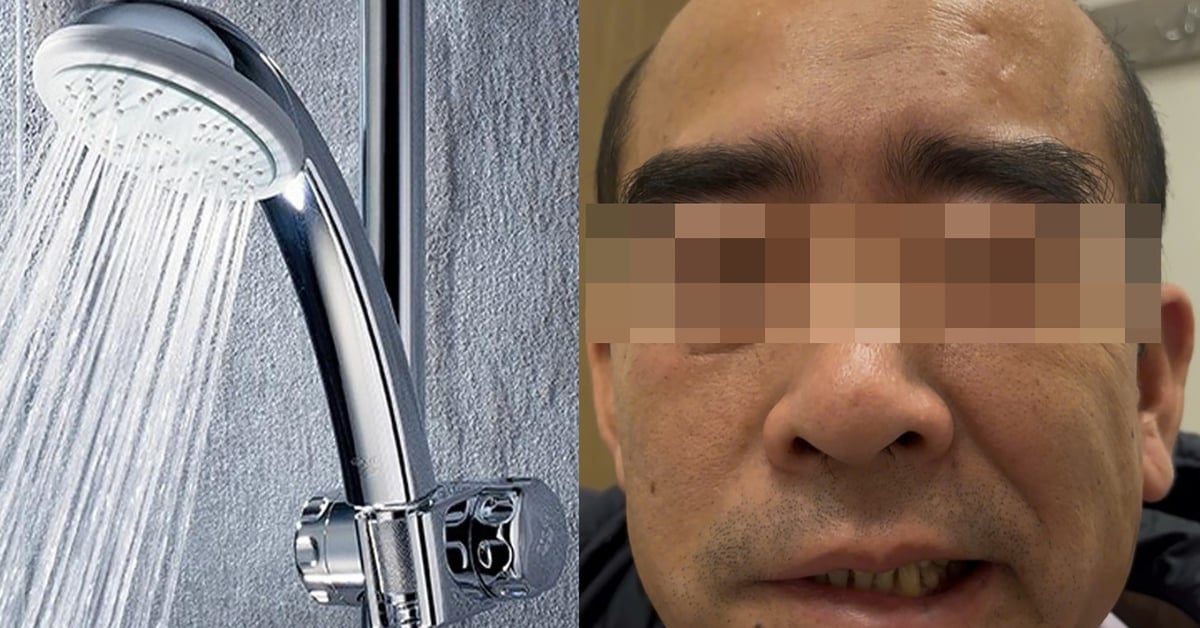Recently, the Stroke Center, Bach Mai Hospital has received many stroke cases of very young age (under 45 years old), accounting for 15% of the total number of patients treated here.
Increasing number of young people having strokes
A 31-year-old male patient, TDQ, was transferred to the Stroke Center in a comatose state, with an endotracheal tube and persistently high blood pressure of 180/100 mmHg. The blood pressure did not decrease even after intravenous medication.
Through medical history, since 2020, the patient had a history of left hemisphere cerebral hemorrhage due to hypertension. When treatment was stable, the patient was sent home to take medication to treat hypertension.
 |
| Illustration |
After a while, the patient saw that his blood pressure was normal, subjectively thinking that the disease was cured, so he stopped taking the medicine without treatment. The patient had a history of using tobacco, beer, and alcohol.
Dr. Nguyen Tien Dung, Deputy Director of the Stroke Center, said that upon admission, the patient's blood pressure continued to rise. The X-ray results showed that the patient continued to bleed on the opposite side of the brain, on the right side, and this time the volume was larger and there was blood in the ventricles.
After consulting with specialists, it was difficult for the patient to undergo surgery because he had bleeding on both sides of the brain and was in a deep coma.
The patient was assigned to continue medical resuscitation. The patient continued to have high fever, slow consciousness, coma, could not be weaned off the ventilator, and had a poor prognosis.
According to experts, cerebral hemorrhage is often sudden and develops rapidly. High blood pressure is the cause of 80-85% of cerebral hemorrhage cases, while 15-20% are caused by secondary cerebral hemorrhage due to ruptured vascular malformations, brain tumors, vasculitis, etc.
Vietnam is one of the countries with the highest incidence of the disease. When a blood vessel is blocked or ruptured, the related part of the brain cannot function, leading to a stroke.
There are two basic types of stroke: cerebral infarction (80%) and cerebral hemorrhage (20%), with varying degrees, from very mild (self-healing, no sequelae) to very severe (life-threatening or immediate death).
Although cerebral hemorrhage occurs less frequently than cerebral infarction, the mortality rate is higher and surviving patients suffer from dementia and severe disability.
The rate of stroke in young people (under 45 years old) accounts for about 10-15%, under 50 years old is 15-20% of the total number of stroke cases. In the world, for every 100,000 people under 50 years old, 15 people have had a brain hemorrhage at least once.
Anyone, including young people, should be screened for stroke because the rate of stroke in young people has been increasing.
Young people are often subjective, rarely monitor blood pressure, rarely exercise, have an overweight or obese diet, and do not go for regular health check-ups. Only when they get sick or have a stroke and have to be hospitalized do they realize they have cardiovascular disease, high blood pressure, etc.
If high blood pressure is detected, it is necessary to maintain regular, lifelong medication, strictly follow the doctor's treatment regimen, have regular check-ups to adjust medication and detect complications early.
Dangerous complications of shingles
Tam Anh General Hospital has just successfully treated a female patient with shingles attacking her eyes, with a history of chickenpox on top of many years of diabetes.
According to Dr. Nguyen Hoang Anh, Department of Internal Medicine, Tam Anh General Hospital, Ho Chi Minh City, the patient had red, rough, blister-like lesions appearing on one side of the patient's face, with a tendency to spread, coinciding with the anatomical location of the facial nerves.
The disease progressed very quickly. Just two days before, the patient had felt a feeling of irritation, itching, stinging, and discomfort inside his right eye, for no apparent reason. After that, the eye became increasingly red, swollen, painful, with blurred vision and watery eyes. At the same time, blisters appeared and spread around the eye.
Shingles attacking the eyes causing severe keratitis like the patient above is a serious case, according to Dr. Hoang Anh.
The longer it is left, the deeper the virus attacks the inner layers of the eye or spreads to other organs. The more dangerous it is when diabetes is present. There is a high risk of losing control of blood sugar, severe bacterial infections, facial nerve paralysis, even myocardial infarction, stroke, severe stress, which is very dangerous.
The patient was admitted to the hospital for emergency treatment. After a multidisciplinary consultation involving internal medicine, neurology, dermatology, ophthalmology, endocrinology and diabetes, the doctor prescribed medical treatment for the patient.
Combine using many types of antiviral drugs, antibiotics, anti-inflammatory drugs, pain relievers, and blood sugar control drugs. At the same time, monitor the risk of Varicella Zoster virus continuing to spread, causing other complications of shingles.
After five days of intensive treatment, the patient's health gradually recovered, the inflammation and redness in his right eye reduced. His vision gradually improved, and the skin lesions gradually disappeared.
The patient did not have any other complications due to shingles. Paraclinical tests were all within normal limits.
Dr. Hoang Anh said that shingles and chickenpox are closely related, both caused by the Varicella Zoster virus.
After chickenpox treatment, the virus still exists and lives latently (dormantly) in the nerve ganglia for many months and years.
When encountering favorable conditions such as immune deficiency, stress, physical weakness, etc., the virus will become active again (wake up), leave its place of residence, move along the nerves to the skin and cause shingles.
People who have had chickenpox and have symptoms of suspected shingles such as rash, pain, fever, fatigue and insomnia should be examined and treated promptly at a general internal medicine, neurology or dermatology specialist.
Avoid leaving it for too long as it can lead to many dangerous complications, even death. Shingrix vaccination is an effective measure to prevent shingles and dangerous complications caused by the Varicella Zoster virus.
Dangerous complications of diabetes
Diabetes is becoming an epidemic, with a high risk of stroke, heart attack, amputation or kidney failure.
Ms. NTS (70 years old, Thai Binh) had half of her left foot amputated and a stent placed in her left femoral artery due to complications from diabetes. Recently, she developed heel ulcers and lost sensation in her limbs, so she went to see a doctor.
Upon entering Bach Mai Hospital (Hanoi), the doctor said that Ms. S. had many complications due to poor blood sugar control, poor diet, and only taking medication when her blood sugar was high. The patient had to be hospitalized to monitor her blood sugar and complications of the disease.
Mr. NTV (71 years old, Nam Dinh) was hospitalized with blood sugar 3-4 times higher than normal.
This patient was diagnosed with diabetes but did not take medication as prescribed or attend regular check-ups. Upon admission, the patient was tired and had difficulty breathing.
The doctor diagnosed heart failure and kidney failure due to complications of diabetes. Not only was this patient's blood sugar high, his blood lipid index was also abnormally high.
According to Dr. Nguyen Quang Bay - Head of the Department of Endocrinology and Diabetes, Bach Mai Hospital, due to late diagnosis and non-compliance with treatment, the patient's complications were very severe and appeared earlier.
Diabetes has many complications. High blood sugar infiltrates every blood vessel, causing damage to large and small blood vessels.
Microvascular complications such as:
Retinopathy is the leading cause of blindness.
Damage to blood vessels in the glomeruli causes kidney failure and requires dialysis. In Vietnam, 1/3 of end-stage renal disease cases require dialysis due to diabetes.
Damages nerves and most frighteningly causes foot ulcers leading to amputation…
Macrovascular complications are the most dangerous because they cause many deaths.
Coronary complications causing myocardial infarction
Carotid cerebrovascular complications causing stroke
Lower limb vascular occlusion, foot ulcer, leg amputation
It is estimated that every 30 seconds, someone in the world has to have a leg amputated due to complications from diabetes.
Dr. Bay recommends that diabetic patients need to have regular check-ups with their doctor, at least every 6-12 months, to screen for all complications.
Vulnerable elderly diabetic patients need to pay attention to avoid hypoglycemia, hypotension, and drug interactions due to polypharmacy.
If you notice any unusual symptoms such as blurred vision, swelling, chest pain or numbness in the limbs before it is time to see a doctor, you should see a specialist immediately.
Elderly diabetic patients also have many other comorbidities such as: high blood pressure, lipid disorders, overweight and obesity and need to control all of these indicators.
Every day, patients should test their capillary blood regularly every day with a capillary blood glucose meter or continuous glucose monitor (CGM), avoid trusting their feelings.
Never stop taking the medicine when you see your blood sugar and blood pressure return to normal, because that result is due to the medicine.
Follow a diet and lifestyle that includes exercise, not overeating, overeating, undereating, or excessive dieting.
Source: https://baodautu.vn/tin-moi-y-te-ngay-712-gia-tang-so-nguoi-tre-mac-dot-quy-d231873.html


![[Photo] General Secretary To Lam receives French Ambassador to Vietnam Olivier Brochet](https://vstatic.vietnam.vn/vietnam/resource/IMAGE/2025/4/17/49224f0f12e84b66a73b17eb251f7278)
![[Photo] Closing of the 4th Summit of the Partnership for Green Growth and the Global Goals](https://vstatic.vietnam.vn/vietnam/resource/IMAGE/2025/4/17/c0a0df9852c84e58be0a8b939189c85a)
![[Photo] National Assembly Chairman Tran Thanh Man meets with outstanding workers in the oil and gas industry](https://vstatic.vietnam.vn/vietnam/resource/IMAGE/2025/4/17/1d0de4026b75434ab34279624db7ee4a)

![[Photo] Nhan Dan Newspaper announces the project "Love Vietnam so much"](https://vstatic.vietnam.vn/vietnam/resource/IMAGE/2025/4/17/362f882012d3432783fc92fab1b3e980)
![[Photo] Promoting friendship, solidarity and cooperation between the armies and people of the two countries](https://vstatic.vietnam.vn/vietnam/resource/IMAGE/2025/4/17/0c4d087864f14092aed77252590b6bae)





















![The Legend of the Pieu Scarf in the Northwest Region [Vietnam Cultural Tourism]](https://vstatic.vietnam.vn/vietnam/resource/IMAGE/2025/4/14/ed2ef5ba2d64465e9651e78816007c13)




![[Photo] Welcoming ceremony for Chinese Defense Minister and delegation for friendship exchange](https://vstatic.vietnam.vn/vietnam/resource/IMAGE/2025/4/17/fadd533046594e5cacbb28de4c4d5655)


























![[Video] Viettel officially puts into operation the largest submarine optical cable line in Vietnam](https://vstatic.vietnam.vn/vietnam/resource/IMAGE/2025/4/17/f19008c6010c4a538cc422cb791ca0a1)


































Comment (0)